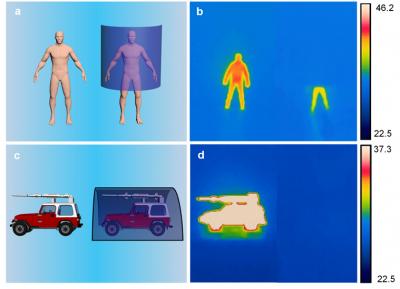'Stealth' material hides hot objects from infrared eyes

A newly developed stealth sheet can hide hot objects like human bodies or military vehicles from infrared cameras. PHOTO BY HONGRUI JIANG
Hiding from such detectors could become much easier, thanks to a new cloaking material that renders objects — and people — practically invisible.
“What we have shown is an ultrathin stealth 'sheet.' Right now, what people have is much heavier metal armor or thermal blankets,” says Hongrui Jiang, professor of electrical and computer engineering at the University of Wisconsin-Madison.
Warm objects like human bodies or tank engines emit heat as infrared light. The new stealth sheet, described this week in the research journal Advanced Engineering Materials, offers substantial improvements over other heat-masking technologies.
“It's a matter of the weight, the cost and ease of use,” says Jiang.
Less than one millimeter thick, the sheet absorbs approximately 94 percent of the infrared light it encounters. Trapping so much light means that warm objects beneath the cloaking material become almost completely invisible to infrared detectors.
Importantly, the stealth material can strongly absorb light in the so-called mid- and long-wavelength infrared range, the type of light emitted by objects at approximately human body temperature.
By incorporating electronic heating elements into the stealth sheet, the researchers have also created a high-tech disguise for tricking infrared cameras.
“You can intentionally deceive an infrared detector by presenting a false heat signature,” says Jiang. “It could conceal a tank by presenting what looks like a simple highway guardrail.”
To trap infrared light, Jiang and colleagues turned to a unique material called black silicon, which is commonly incorporated into solar cells. Black silicon absorbs light because it consists of millions of microscopic needles (called nanowires) all pointing upward like a densely-packed forest. Incoming light reflects back and forth between the vertical spires, bouncing around within the material instead of escaping.
Although black silicon has long been known to absorb visible light, Jiang and colleagues were the first to see the material's potential for trapping infrared. They boosted its absorptive properties by tweaking the method through which they created their material.
“We didn't completely reinvent the whole process, but we did extend the process to much taller nanowires,” says Jiang, who developed the material in National Science Foundation-supported facilities at UW-Madison.
They make those nanowires by using tiny particles of silver to help etch down into a thin layer of solid silicon, which results in a thicket of tall needles. Both the nanowires and the silver particles contribute to absorbing infrared light.
The researchers' black silicon also has a flexible backing interspersed with small air channels. Those air channels prevent the stealth sheet from heating up too quickly as it absorbs infrared light.
###
Jiang and colleagues are working to scale up their prototype for real-world applications with assistance from UW-Madison's Discovery to Product program. They received a U.S. patent in the fall for the material's use in stealth. The Wisconsin Alumni Research Foundation supported the research through its Robert Draper Technology Innovation Fund, and is actively pursuing two additional patent applications.
Media Contact
All latest news from the category: Power and Electrical Engineering
This topic covers issues related to energy generation, conversion, transportation and consumption and how the industry is addressing the challenge of energy efficiency in general.
innovations-report provides in-depth and informative reports and articles on subjects ranging from wind energy, fuel cell technology, solar energy, geothermal energy, petroleum, gas, nuclear engineering, alternative energy and energy efficiency to fusion, hydrogen and superconductor technologies.
Newest articles

Long-sought structure of powerful anticancer natural product
…solved by integrated approach. A collaborative effort by the research groups of Professor Haruhiko Fuwa from Chuo University and Professor Masashi Tsuda from Kochi University has culminated in the structure…

Making a difference: Efficient water harvesting from air possible
Copolymer solution uses water-loving differential to induce desorption at lower temperatures. Harvesting water from the air and decreasing humidity are crucial to realizing a more comfortable life for humanity. Water-adsorption…

In major materials breakthrough
UVA team solves a nearly 200-year-old challenge in polymers. UVA researchers defy materials science rules with molecules that release stored length to decouple stiffness and stretchability. Researchers at the University…



